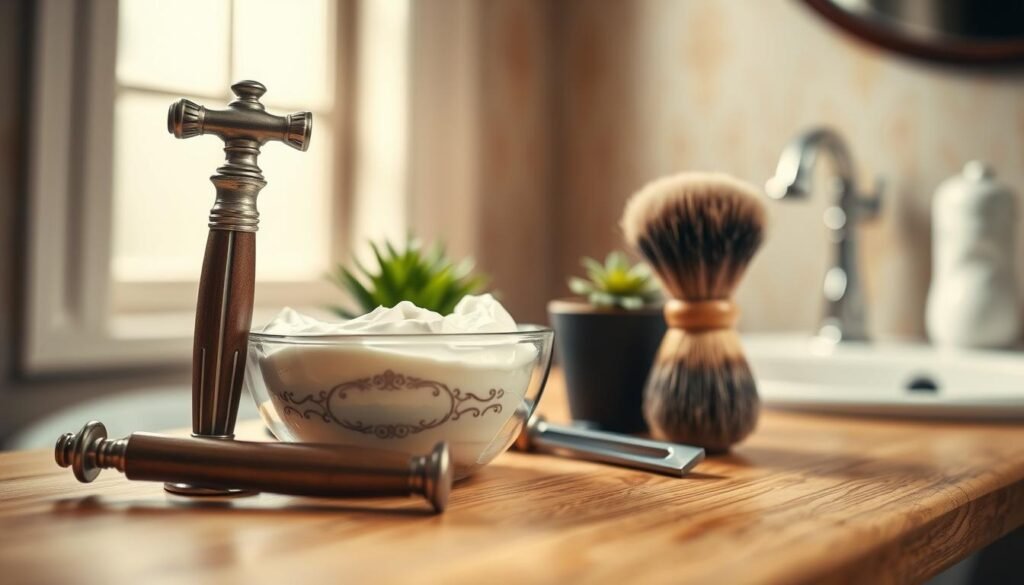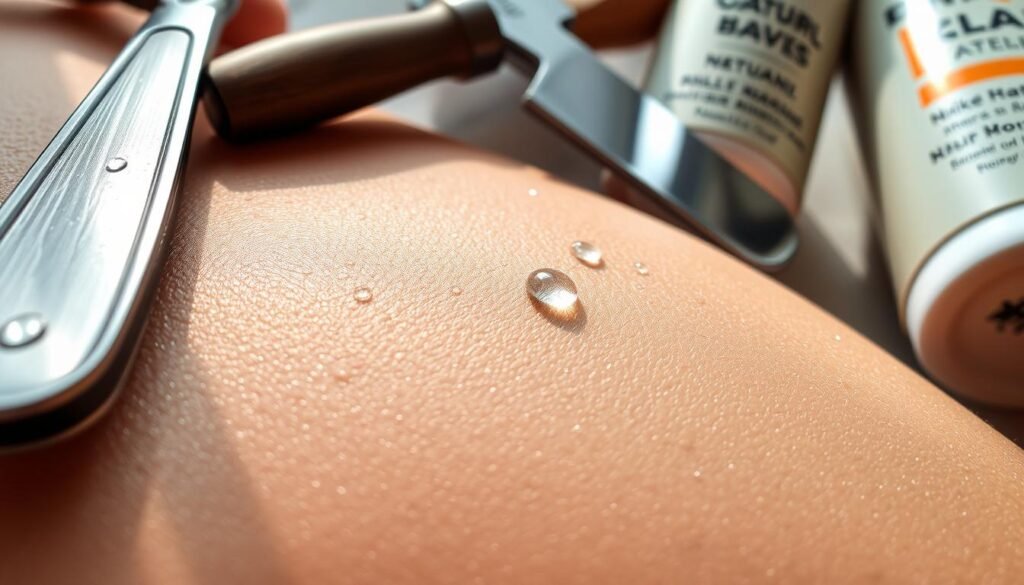
Board-certified dermatologists say shaving is a common way to remove unwanted hair. But, it can cause razor bumps. I’ll share expert tips to help you avoid these bumps and get a smooth shave.
Razor bumps can lead to permanent skin damage if not treated. Dermatologists have advice to keep your skin healthy and smooth.
Key Takeaways
- Understand your hair type and its susceptibility to razor bumps
- Invest in quality grooming tools to minimize irritation
- Establish a regular trimming routine to keep hair manageable
- Practice smart shaving techniques with the right products
- Moisturize after grooming to soothe and nourish the skin
Understanding Razor Bumps
What Are Razor Bumps?
Razor bumps, also known as pseudofolliculitis barbae (PFB), happen after shaving. They are a type of folliculitis. Hairs curl back and get trapped by dead skin or a clogged follicle.
In bad cases, these trapped hairs can turn into painful, infected ingrown hairs. You can also get non-inflamed bumps on the skin’s surface.
Causes of Razor Bumps
Razor bumps often show up on the face and neck. This is because men shave these areas a lot, and the hair is thicker. Genetics also matter, as coarse or curly hair is more likely to get trapped.
Other things that can cause razor bumps include:
- Skin folds and scar tissue
- Tightly curling hair
- Hair growth direction
- Hair type
- Genetic features related to keratin in the hair follicle
Shaving too close, shaving under the jawline, and plucking hair in sensitive spots can also lead to shaving irritation, ingrown hairs, and folliculitis.
“Razor bumps may take around 3 months to disappear after stopping shaving.”

How to Prevent Razor Bumps
Stop Shaving and Let Hair Grow
The best way to avoid ingrown hairs is to stop shaving and let your hair. This lets the hair come out naturally. It lowers the chance of it getting trapped and causing irritation.
If you want to look clean-shaven, there are ways to prevent razor bumps. You can use special techniques.
Shave in the Right Direction
Shaving with the grain is key to avoiding razor bumps, especially for coarse or curly hair. The American Academy of Dermatology says shaving against the grain can cause more irritation. It also increases the chance of ingrown hairs.
To find the hair growth direction, gently run your fingers over the area. See which way your hairs point. Then, shave in that direction. This simple change can greatly reduce razor bumps.

“Shaving in the same direction that your hairs grow will often make the biggest difference for bump-prone skin, significantly reducing the number of hairs that get trapped.”
Proper Shaving Techniques
To avoid razor bumps, it’s key to shave right. Shave after a warm shower or use a warm, damp cloth. This makes hairs swell, reducing the chance of bumps.
Choosing the right shaving products is also vital. Use a moisturizing cream or gel to soften hair. A pre-shave oil can also help, making shaving smoother.
| Shaving Technique | Benefit |
|---|---|
| Shave After a Warm Shower | Loosens hairs and causes them to swell, reducing the risk of ingrown hairs |
| Use a Moisturizing Shaving Cream or Gel | Softens the hair and helps provide a smooth, comfortable shave |
| Apply a Pre-Shave Oil | Further softens the hair and prepares the skin for shaving |
By using these techniques, you can avoid razor bumps. Enjoy a smooth shave every time.

How to prevent razor bumps
Many people want a smooth shave without bumps. The secret is in how you shave and take care of your skin after. By using the right methods, you can avoid razor bumps and keep your skin looking great.
Shaving with the hair growth direction is key. Shaving against the grain can cause ingrown hairs and bumps. Also, change your razor blades every 5-7 shaves to reduce irritation.
Getting ready to shave is important too. Shave after a warm shower or use pre-shave oil to soften hair. Use a moisturizing cream and avoid dry shaving to lower bump risk.
For those who get bumps, try an electric rotary shaver. It cuts hair in many directions without shaving too close. Safety razors with double-sided blades are also good, as they cause less irritation.
After shaving, take care of your skin. Use a soothing aftershave balm or moisturizer to calm it. Exfoliating with a gentle method can also help keep your skin healthy and prevent bumps.
“Consistency is key when it comes to preventing razor bumps. Stick to a routine that works for your skin, and you’ll be on your way to a smooth, bump-free shave.” – Dr. Sarah Bernstein, Dermatologist
By following these tips, you can control your shaving and avoid razor bumps. Say goodbye to those annoying bumps and enjoy a smooth shave.

Exfoliation for Smoother Shaves
Getting a smooth shave starts with exfoliation. Exfoliating lifts hairs off the skin, making it ready for shaving. But, be careful if your skin is already sore from shaving.
Those with razor bumps or sensitive skin should avoid scrubs. Instead, use chemical exfoliants or peel pads with glycolic acid, salicylic acid, or polyhydroxy acid. These help remove dead skin, kill bacteria, and reduce bumps, making hairs easier to remove.
Exfoliating before shaving is important. But listen to your skin. If it’s sore, skip exfoliation and focus on hydrating and soothing it after shaving. The right exfoliation routine can make shaving smoother and less irritating.
“Exfoliating before shaving helps prepare the skin and stimulate collagen production for a more comfortable shave,” explains Dr. Bullock, a dermatologist specializing in shave-related skin concerns.
Remember, proper shaving technique and the right tools are key to avoiding razor bumps. Smart exfoliation and careful shaving can give you a close, smooth shave with less irritation.
Choosing the Right Razor
Finding the right razor can be tough, especially if you get razor bumps and irritation. But, with the right tools and techniques, you can get a smooth shave. This won’t hurt your skin. Let’s look at what to consider when picking the best razor for your skin.
Safety Razors vs. Cartridge Razors
People with sensitive skin should try a safety razor with double-sided blades. Safety razors are gentler than cartridge razors. They have fewer blades, which means less chance of cutting too close and causing irritation.
Cartridge razors have many blades. This can make them pull on your hair, leading to ingrown hairs and bumps. Safety razors, on the other hand, give a precise shave. You can adjust the angle and pressure to fit your skin’s needs.
Electric Razors for Sensitive Skin
Electric razors are also good for sensitive skin, especially rotary models with round heads. These razors give a close shave without cutting too deep. This makes them great for those who get bumps and irritation.
New electric razor models are made to be gentle. They help avoid ingrown hairs and skin irritation. By looking at different electric razors, you can find one that works well for your skin.

Finding the right razor is all about knowing your skin. Try different razors and methods to find the best one. This way, your skin stays smooth, healthy, and bump-free.
Shaving Frequency and Hair Length
Shaving frequency and hair length are key to avoiding razor bumps. Shaving daily or every 2-3 days helps keep hair short. This reduces the risk of razor bumps. But, shaving too soon can still irritate your skin.
Before shaving, check your stubble length. Decide if you need to shave or let it grow longer. This choice affects your skin health.
Men with fast-growing hair might shave daily. Those with sensitive skin might shave every other day. Men with sparse hair can shave weekly for a stylish look.
For longer beards, trimming every 6-8 weeks keeps it neat. Your skin type and hair growth guide your shaving frequency. Oily skin may get more breakouts, while dry skin gets irritated easily.
Try different shaving frequencies and see how your skin reacts. This helps find the best way to avoid razor bumps and keep your skin smooth.
“Shaving correctly is critical to avoid rashes, dryness, and discomfort caused by shaving.”
Post-Shave Skincare Routine
After shaving, it’s key to care for your skin with a good skincare routine. This helps calm any irritation and makes your skin healthier. Using the right post-shave skincare products and methods can say goodbye to razor bumps. You’ll get a smooth, comfy finish.
Soothing Aftershave Balms
Right after shaving, splash cold water on your face. This tightens pores and lessens swelling. Then, use a gentle, alcohol-free aftershave balm to ease any razor burn or irritation. These balms have ingredients like aloe vera, witch hazel, and vitamin E. They soothe and hydrate your skin.
Moisturizing for Healthy Skin
Don’t skip moisturizing after shaving. Use a rich, fragrance-free moisturizer to replace lost oils and keep your skin glowing. Focus on areas that got more friction or irritation. Keeping your skin moisturized prevents dryness, flakiness, and irritation.
By sticking to a detailed post-shave skincare routine, your skin stays hydrated and calm, even after a close shave. Choosing the right aftershave balms and moisturizers is crucial for your skin health. It ensures a smooth, comfortable shave every time.
Alternative Hair Removal Methods
If you’re tired of razor bumps, there are better ways to remove hair. Laser hair removal and waxing are great because they get rid of hair at the root. This stops the irritation that razors can cause.
These methods might cost more or feel uncomfortable at first. But, they can make your skin smooth and bump-free. Let’s look at some options and their benefits.
Laser Hair Removal
Laser hair removal uses light to stop hair follicles from growing. It works best for thick or dark hair. After 6 or more treatments, you can see lasting results.
Waxing
Waxing uses hot or cold wax to remove hair from the root. It can make your skin smooth for weeks. But, it might hurt more than shaving. Wait 3-4 weeks before waxing again to let hair grow.
| Method | Duration of Results | Potential Side Effects |
|---|---|---|
| Laser Hair Removal | Long-lasting, potentially permanent | Temporary skin irritation, redness |
| Waxing | 2-6 weeks | Temporary redness, ingrown hairs |
| Depilatories | 1-2 weeks | Skin irritation, allergic reactions |
| Threading | 4-5 weeks | Temporary redness, skin irritation |
Even with these methods, you might still get razor bumps or skin irritation. But, with the right prep, technique, and care, you can avoid these problems. This way, you can get the smooth, bump-free skin you want.
Conclusion
To prevent razor bumps, you need to do a few things. First, shave in the right direction. Use good products and take care of your skin after shaving. This way, you can avoid bumps and keep your skin healthy.
For more tips, check out this article on hair removal. It might help if you’re still getting bumps.
Razor bumps can be annoying, but you can beat them. Just take care of your skin and shave right. Stay on top of your routine to avoid bumps and look great.
Don’t let razor bumps win. Learn how to take care of your skin and shave well. Use the right products and skincare after. This will help you get smooth skin without bumps.
